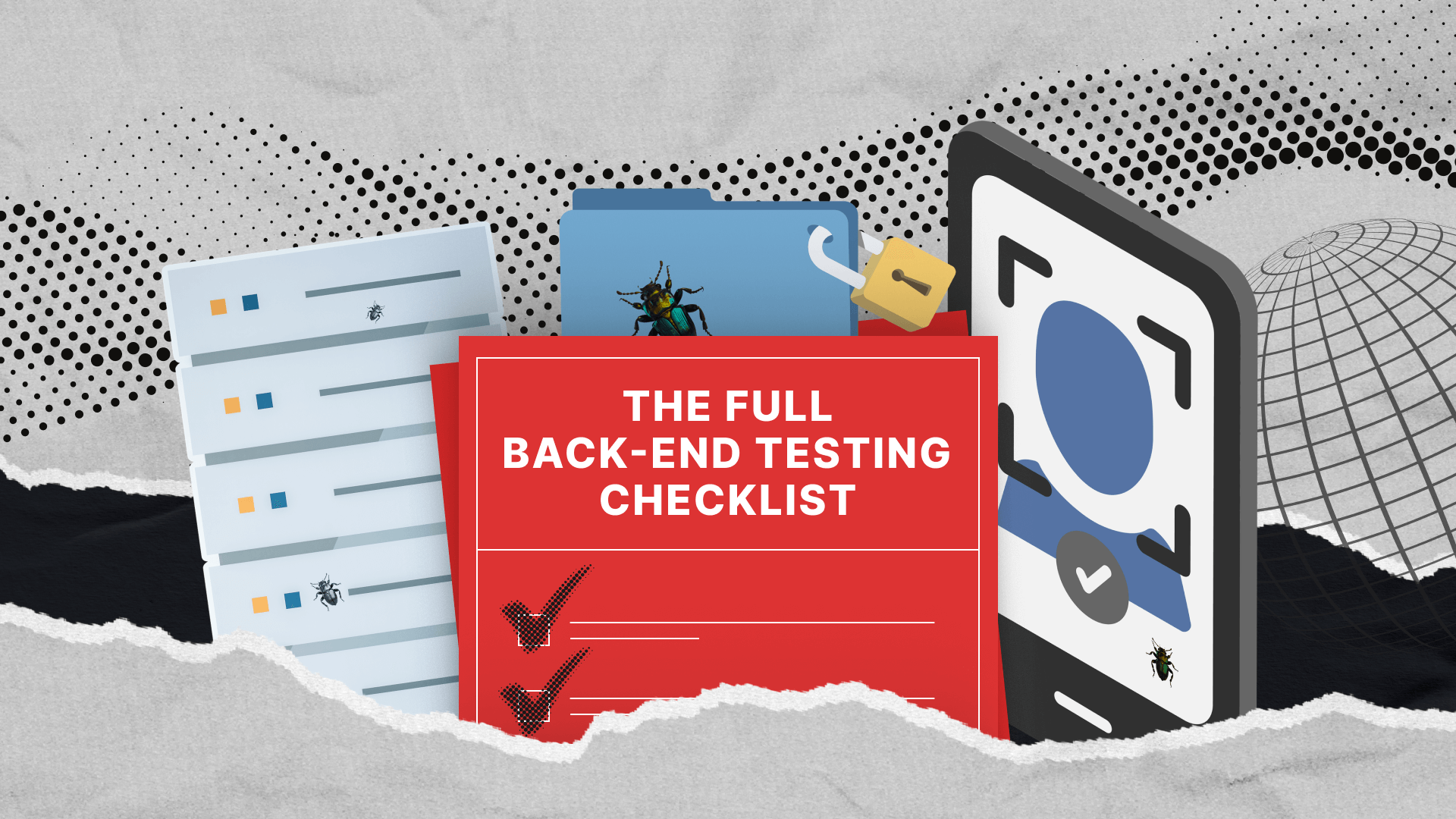Back-end testing is the goalkeeper guarding your software development quality gates from major issues. It’s more than just checking your code — it’s about making sure the entire background process of your application, including databases and servers, operates smoothly.
We converted our extensive experience of around a decade into a comprehensive back-end testing checklist. These points on our checklist will help you catch any potential problems before they make an impact, and ensure that you have built a reliable and efficient application.
Step-By-Step Guide on Back-End Testing
Back-end testing ensures that everything behind the scenes—like servers, databases, and APIs—works smoothly. We’ll walk you through each step of the core functions of back-end testing, helping you build a more stable, secure, and reliable application.
Initial Setup and Configuration for Back-End Testing
Setting up for back-end testing is a critical phase that lays the groundwork for all subsequent testing activities. Our listed points focus on the essential steps needed to prepare your environment, ensuring that tests are relevant and reliable.
Testing Environment Setup:
- Choose a server environment that mirrors the production setup to ensure test results reflect real-world performance
- Use containerization tools like Docker to accurately replicate software, system libraries, and configurations
- Ensure the test environment can be easily reset or reconfigured for different test scenarios
Database Configuration:
- Set up a test database that mimics the production database’s schema and structure
- Populate the test database with representative data that covers a wide range of test cases, while ensuring sensitive information is anonymized
- Establish a process for regularly updating the test database to reflect any changes in the production database schema
Back-End Services and API Initial Configuration:
- Configure internal APIs and back-end services, ensuring they are operational and accessible within the test environment
- Establish basic validation checks for API endpoints to confirm they are functioning as expected
- Set up initial mock services or stubs for external dependencies to allow testing of integration points
Database Testing
Database testing is pivotal in back-end system validation, focusing on data integrity, performance, and security. This part of our back-end testing checklist aims to uncover potential issues that could impact the back-end’s functionality and performance, ensuring the database supports the application’s requirements effectively.
Data Integrity and Accuracy Testing:
- Test for data consistency post-transaction to ensure updates, inserts, and deletes are correctly reflected
- Validate data integrity across different tables, especially after complex transactions or batch operations
- Implement automated comparisons between expected and actual data after various operations, focusing on data accuracy in line with business rules
Data Format and Type Validation:
- Rigorously check data types, formats, and constraints (like foreign keys and unique constraints) to ensure data adheres to schema specifications
- Test the handling of null and default values, particularly in critical fields, to prevent application errors or data corruption
- Assess the system’s handling of extreme and unexpected data values, focusing on boundary value analysis and stress testing
Data-Related Functionality Testing:
- Verify the accuracy and performance of stored procedures, triggers, and database views, ensuring they function as intended under various conditions
- Test the application’s data filtering, sorting, and aggregation features to ensure they accurately reflect the underlying database logic
- Evaluate the database’s handling of complex queries, particularly those involving joins, subqueries, and nested queries, for correctness and efficiency
Data Security Testing:
- Conduct specific tests for SQL injection vulnerabilities and other data-related security threats
- Verify the implementation of data encryption at rest and in transit, focusing on sensitive data protection
- Test data access controls, ensuring proper implementation of user roles and permissions per the principle of least privilege
Data Performance Testing:
- Measure and optimize query performance, particularly focusing on long-running and frequently used queries.
- Test the impact of indexing on data retrieval performance and the database’s ability to handle large volumes of data efficiently.
- Evaluate the database’s response to high data volume and user load, focusing on stress testing and scalability
API Testing
API testing is a vital component of back-end testing, ensuring that the application’s communication layer functions correctly, securely, and efficiently. This section of the checklist is dedicated to methodically testing API functionalities, error-handling mechanisms, security aspects, and performance. Each category is designed to uncover potential issues in the API layer that could affect the overall application performance and user experience.
Functionality Testing:
- Validate endpoint-specific business logic, ensuring each API performs its intended function correctly
- Test APIs with different HTTP methods (GET, POST, PUT, DELETE) to verify correct handling of each method
- Examine API responses for different user roles, checking if data filtering and access control are correctly applied
- Assess how the API handles null or incomplete data inputs, ensuring graceful degradation
Error Handling:
- Test for correct HTTP status codes (e.g., 404 for bad requests and 403 for unauthorized access) in various scenarios
- Validate custom error messages for clarity and usefulness while ensuring they don’t leak sensitive information
- Simulate back-end service failures to examine API fallback mechanisms and error propagation
Security Testing:
- Conduct penetration tests targeting authentication, session management, and access control vulnerabilities
- Test for exposure of sensitive data like API keys, tokens, and personal information.
- Evaluate rate limiting and throttling mechanisms to prevent abuse and denial-of-service attacks
- For authorization, verify compliance with relevant security standards and best practices, like OAuth
Performance Testing:
- Measure API latency under different load conditions to assess responsiveness
- Evaluate the efficiency of data pagination and filtering in reducing payload sizes and improving response times
- Test long-running API processes to check for timeouts and performance degradation
- Assess caching mechanisms’ effectiveness in reducing API load and improving response times
Server Testing
Server testing focuses on ensuring its stability, security, and performance under various conditions. This piece of the checklist aims to identify potential vulnerabilities and inefficiencies in the server setup. By thoroughly evaluating these areas, the testing ensures the back-end’s server infrastructure is capable of effectively supporting the application’s requirements.
Server Security Testing:
- Execute targeted vulnerability assessments to identify weak spots in server defenses
- Conduct penetration testing focused on server-specific vulnerabilities, such as buffer overflows or insecure server configurations
- Test for robust SSL/TLS implementation, ensuring encryption standards meet top current practices
- Assess server defenses against DDoS attacks and rate-limiting effectiveness to prevent service disruptions
Server Configuration and Deployment Testing:
- Validate server configurations against industry benchmarks and best practices for optimized performance and security
- Automate and test deployment pipelines, including blue-green deployments, to evaluate the reliability of updates with zero downtime
- Ensure configuration management tools effectively maintain consistency across all environments
Server Failover and Recovery Testing:
- Simulate different failure scenarios to validate the effectiveness of failover strategies in real-world conditions
- Test backup integrity and recovery procedures under varying scenarios, focusing on data completeness and time-to-recovery
- Evaluate load balancing and auto-scaling solutions under failure conditions, ensuring seamless user experience during server outages
Integration Testing
Integration testing assesses the interaction between various components of the back-end system, ensuring seamless operation and data flow. This part focuses on methodologies and strategies to effectively test the integration of different modules, APIs, databases, and other back-end services. The aim is to identify any discrepancies, incompatibilities, or data inconsistencies that could arise when different parts of the system work together.
Module Integration Testing:
- Test the data exchange and function calls between different modules, ensuring they interact as expected
- Focus on boundary conditions where modules interface, checking for data format compatibility and correct data transfer
- Simulate module failures to assess the impact on the overall system and verify robust error handling and logging
API and Service Integration Testing:
- Validate the integration of internal and external APIs, ensuring they communicate correctly and adhere to specified protocols
- Test API gateways and service meshes for efficient routing, load balancing, and fault tolerance in a microservices architecture
- Evaluate the handling of API dependencies, particularly in scenarios where external services are slow or unavailable
Database Integration Testing:
- Verify that applications correctly interact with the database, including read/write operations, transactions, and data retrieval
- Test for data consistency across different database operations, especially in distributed database environments
- Assess the impact of database schema changes on integrated applications, ensuring backward compatibility
End-to-End Workflow Testing:
- Execute comprehensive end-to-end tests that mimic real-world scenarios, covering the entire flow of data and processes
- Test critical workflows for different user roles and permissions, ensuring correct data access and processing
- Analyze the system’s behavior under various failure conditions, such as network issues or service downtimes, to evaluate resilience and recovery mechanisms
Security Testing
Security testing is a critical aspect of ensuring the back-end infrastructure is safeguarded against potential threats and vulnerabilities. This part focuses on rigorous testing of authentication and authorization mechanisms, comprehensive vulnerability scanning, and in-depth penetration testing. The objective is to identify and rectify security weaknesses, thereby reinforcing the overall security posture of the back-end system.
Authentication and Authorization Tests:
- Examine the strength of authentication methods, focusing on edge cases like rapid login attempts or unusual input patterns
- Analyze the security of user data during transmission and storage in authentication processes
- Test role-based access controls with intricate scenarios, including temporary or escalating privileges
- Evaluate the effectiveness of token revocation and session expiration strategies in preventing unauthorized access
Vulnerability Scanning:
- Utilize advanced vulnerability scanners to detect common issues in the back-end infrastructure
- Implement continuous scanning protocols as part of the CI/CD pipeline, ensuring constant vigilance
- Prioritize identified vulnerabilities not just by severity, but also by their contextual impact on the overall system
Penetration Testing:
- Conduct targeted attack simulations, focusing on areas most critical to the back-end’s operations
- Explore beyond standard OWASP Top 10 vulnerabilities, investigating potential business logic flaws
- Test the back-end’s response to various attack vectors, including those exploiting third-party integrations
- Critically assess the incident response process following simulated breaches to enhance future readiness
Performance Testing
Performance testing in the back-end environment ensures that the system operates efficiently under various conditions. The aim of this part is to optimize the back-end’s performance, ensuring that it meets the necessary standards for speed, scalability, and stability.
Response Time:
- Conduct layered response time analysis to differentiate between processing, network, and database query delays
- Implement automated performance tests in different geographical regions using cloud-based testing tools to understand global performance impacts
- Examine the performance of API endpoints in detail, especially under varying load conditions, to identify and optimize slow-performing requests
Concurrency Testing:
- Execute advanced concurrency testing to observe how the back-end manages simultaneous operations, focusing on thread management and locking mechanisms
- Utilize synthetic transaction loads to mimic real-world user behavior patterns, assessing system resilience under realistic conditions
- Incorporate testing for the back-end’s ability to handle sudden and unexpected spikes in traffic, evaluating its auto-scaling and load-balancing capabilities
Resource Usage:
- Integrate resource usage profiling within the CI/CD pipeline to continuously monitor CPU, memory, and disk usage during development phases
- Analyze the impact of new features or updates on the back-end’s resource consumption to preemptively address performance degradation
- Test database optimization strategies, such as indexing and query optimization, for their effect on reducing server load and improving overall efficiency
Our Experience with Back-End Testing
Software testing is QAwerk’s strong suit, with back-end testing being a vital part of the armor, protecting you from bugs stabbing you in the back. We have 9+ years of extensive experience providing both manual and automated testing services, and we have an impressive portfolio to back it up. Check out this example of a successful case focused on back-end testing solutions.
Couple Up!
Couple Up! is an interactive mobile game that simulates a love reality show designed for iOS and Android players. It was created by Native Games Studio, a relatively young but promising indie game developer.
The QAwerk team has provided profound performance testing to find and fix any bugs and glitches that can affect the app’s functioning and overall user experience. The goal was to ensure effective operation and avoid slugs and crashes with a constantly growing user base.
Our primary focus was on the back end, so we conducted load testing, audited server configurations, and thoroughly reviewed the API codebase. We also assisted in determining which test cases were making the server struggle and react slowly.
After performing in-depth testing and discovering all problematic areas, we shared our insights on how to boost game performance, including changing database options, switching to a new architecture, and improving the quality of the API code. With our help, Couple Up! is now up for large-scale gaming and a dramatic increase in user base.
Final Thoughts
Anytime your business is tied to software development, you strive for a positive user experience, flawless operation, and overall perfect quality. Wanna keep your scores high? Train your goalkeeper, which in the case of software solutions, is back-end testing.
By using efficient back-end testing techniques and tools, our skillful QA engineers can find problems before the program is made available to end users. This improves the application’s general reputation and user experience and saves time and resources. Use our checklist to guide you on this journey to perfection.
Sometimes, you need a fresh set of eyes to review your code and see the problem from a different angle. That is when partnering with an experienced specialist will be a smart move. Let us help you achieve your project goals and deliver a superior product.
See how we helped Couple Up!
improve server response times
with load testing and better server configuration


